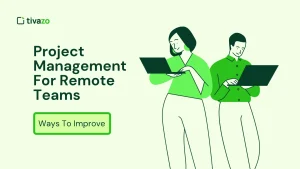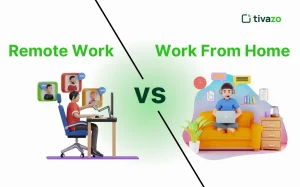Did you ever notice that your words just disappear among the many Slack notifications, making communication difficult? That’s where remote work etiquette comes in.
Remote work is different than being in an office, as it means different attitudes, habits, and behaviors. Since many professionals are now involved in flexible and hybrid work, understanding remote work etiquette has become very important. Everyone should know when and when not to do certain tasks online so they can trust colleagues, improve work efficiency, and act professionally.
This guide will reveal the main ten tips on remote work etiquette that every professional should remember. While exploring the topic, we’ll draw from the best sources and show you things most guides do not include. Before we go any further, we should understand what the difficulties are in remote work.
Key Highlights:
- Challenges of Remote Work
- Top 10 10 Remote Work Etiquette
- How Tivazo Can Help Enhance Remote Work Etiquette
- Industry-Specific Remote Work Etiquette Tips
- The Future of Remote Work Etiquette
Top 3 Challenges of Remote Work
Remote work is very flexible, but it presents different challenges that may affect a person’s performance and well-being. First, you should understand these issues to help you handle them and be productive in your virtual role.

1. Communication Barriers and Misunderstandings
Among the major problems for remote workers is making sure communication is clear and strong. Because we do not interact face-to-face, messages might be interpreted wrongly, and important gestures might be missed, which results in mistakes and extra time. Extra effort and needed manners in using video calls, instant messaging, and project collaboration platforms are the keys to overcoming such challenges.
2. Managing Distractions and Maintaining Focus
Being at home for work usually means having to deal with noise, having family disturb the work routine, and facing plenty of things that are not work-related. Because of these problems, it becomes tough to pay attention, and the amount you produce at work tends to suffer. If you create a place specifically for working and use tools such as the Pomodoro method, you can concentrate better and make it obvious to your family that you are engaged in your job.
3. Feeling Isolated and Disconnected from the Team
Remote work can sometimes lead to feelings of loneliness and social isolation since spontaneous conversations and casual team bonding moments are rare. This lack of connection can affect motivation and mental health. Regular virtual check-ins, team-building activities, and proactive communication are essential to foster a sense of belonging and collaboration.
While these challenges can feel daunting, they are manageable with the right strategies and mindset. By recognizing and addressing communication gaps, distractions, and isolation, remote professionals can create a more productive and fulfilling work-from-home experience.
10 Remote Work Etiquette Tips You Need To Know

1. Create a Dedicated Workspace
The first thing to do in remote work etiquette is to draw a line between your work and personal time.
Checking the same report from 2023, only a little over a third of remote workers (32%) said they had a separate home office space; meanwhile, 81% reported mainly working from their homes. A lack of an assigned office space leads to more distractions and hurts a person’s professionalism.
Even the smallest, well-organized area filled with a desk, a comfortable chair, and the right light will give you more focus and make others think you’re on a work break.
2. Respect Schedules and Time Zones
Teams that do their work remotely are likely to be in different time zones. It’s very common for people to make remote work etiquette mistakes by asking for an instant reply or arranging a meeting without keeping everyone’s location in mind.
Try using online tools such as Calendly and World Time Buddy to manage your schedule without offending other people.
Since remote workers take part in 25% more meetings, proper scheduling wisdom becomes even more necessary.
3. Dress for the Camera
It’s true that working from home feels nice, but not appearing at meetings in pajamas is still important for businesspeople.
Try to look the same way you would in person, starting from the top of your body. It demonstrates respect and makes you ready to handle your workday well.
Most dress guides do not discuss the psychological effects of what people wear. Many studies have shown that your appearance can boost your confidence and productivity, no matter if you are working from home or at a company office.
4. Keep Your Camera On (When Appropriate)
When you turn on your camera during remote meetings, it encourages trust and builds a better bond. It was found by Microsoft that people who use video in their teams work together more closely and feel more involved.
In most cases, you should leave your camera on to make sure you experience everything in the office. Try to always face the camera, show a friendly smile, and remove any objects that may distract you from the background.
Pro Tip: If possible, get a good webcam and either go with a solid background or blur the images to improve how you look on screen.
5. Mute When Not Speaking
Background noise is a frequent problem people experience in online meetings. Noises like barking dogs and typing interfere with the way teams work.
Try to keep your microphone on mute until you are the current speaker. With hotkeys, you can easily turn the mute feature on and off.
Feature point: A lot of blogs fail to mention that Krisp and Zoom settings are useful for filtering background noise during remote calls.
6. Communicate Proactively and Clearly
Communication plays a vital role in following proper remote work etiquette. Relying only on casual discussions is too risky, so it’s important to keep people updated actively.
Projects like Asana, Trello, and Slack are helpful because you can update each other, clarify anything unclear, and discuss what is required for the project.
If remote workers are too precise about how they communicate, they are likely to deal with less confusion and delays, says Harvard Business Review.
7. Be Punctual and Prepared for Meetings
Being on time respects the time your team gives to you. Coming in late to a meeting is bad for the group’s progress and makes a negative mark.
It is good to log in about 2–3 minutes ahead of time. Learn ahead if your mic, webcam, and internet will work properly.
It is a good idea to send over an agenda to attendees before the meeting. Many people miss this tip, but it encourages everyone to stay attentive and makes the meeting better.
8. Use Professional Language and Tone
It is easy for the tone in digital messages to get interpreted wrongly. Things that seem natural to one person could be taken as rude by others.
Remember to speak politely and not make your message too long. Avoid making your messages sarcastic and don’t type in all caps. Use emojis if you think they are useful, but don’t place too many in your emails.
Make your writing clear by adding “/gen,” like “genuine,” after a message or “/j,” like “joking,” in front of a message.
You May Also Like: How to Be More Confident at Work: 7 Bold Tips
9. Take Breaks Without Disappearing
Taking time off from work is beneficial, but not disappearing at all is not a good practice. Let your team know if you will be absent for more than just a few moments.
Tip: Share your status on either Slack or Teams. Apply the Do Not Disturb mode to keep your work time undisturbed.
A study by TINYpulse has found that three out of every four remote workers often feel isolated from communication at work, mainly due to it being unclear when they are around.
10. Respect Digital Boundaries
Being online does not always mean that someone is free to talk to you. Try not to send messages during your personal hours unless it’s very important.
Tip: You could schedule an email in advance or just send it while regular hours are active.
Team-wide “quiet hours” is a strategy to support everyone in the group by giving them time for rest. These measures can help workers avoid burnout since this is a common remote work issue.
How Tivazo Can Help Enhance Remote Work Etiquette

Tivazo offers powerful remote work solutions that streamline communication and collaboration, essential for maintaining proper remote work etiquette. With features like employee monitoring and time tracking, Tivazo helps teams stay updated, punctual, and professional. Its intuitive platform encourages clear communication, respects digital boundaries, and supports productivity across time zones. By integrating Tivazo into your workflow, you can foster better remote work etiquette, reduce misunderstandings, and boost team morale, key factors for successful remote work etiquette.
Industry-Specific Remote Work Etiquette Tips: Tailoring Your Approach for Success
Remote work etiquette isn’t one-size-fits-all. Different industries have unique expectations, communication styles, and tools, making it essential to adapt your remote work etiquetteaccordingly. Here’s a breakdown of best practices for some key sectors to help you shine as a remote professional in your field.
1. Healthcare
In healthcare, remote work often involves telemedicine, administrative tasks, or collaboration on patient care. Here, remote etiquette means:
- Strict confidentiality: Always follow HIPAA or relevant privacy laws when sharing patient information over video calls or messaging apps.
- Clear, compassionate communication: Tone matters more than ever in virtual care; be empathetic and patient-centered.
- Prompt response to urgent messages: Healthcare is time-sensitive—respond quickly to colleagues’ queries or patient needs.
- Professional appearance: Dress appropriately for video consultations to build patient trust and convey competence.
Tools commonly used: Telehealth platforms, secure messaging apps (e.g., TigerConnect), EHR software.
2. Education
Educators working remotely face unique etiquette challenges in virtual classrooms and meetings with parents or colleagues:
- Set clear expectations: Communicate class rules, participation guidelines, and office hours upfront.
- Maintain punctuality: Start and end sessions on time to respect students’ schedules.
- Active engagement: Use interactive tools (polls, breakout rooms) and keep cameras on when possible to foster connection.
- Respect privacy: Avoid recording or sharing student data without permission, and use secure platforms.
Tools commonly used: Zoom, Google Classroom, Microsoft Teams, Kahoot.
3. Software Development
Developers often work asynchronously and rely heavily on written communication. Key etiquette tips include:
- Write clear, detailed documentation: Make code comments, pull requests, and bug reports easy to understand.
- Respect code review schedules: Provide timely feedback and don’t delay merges without explanation.
- Use status updates: Keep the team informed on progress via tools like Jira or Slack.
- Avoid interrupting deep work: Use “Do Not Disturb” modes and schedule meetings thoughtfully.
Tools commonly used: GitHub, Jira, Slack, Visual Studio Code Live Share.
4. Customer Service
Remote customer service reps must manage a high volume of interactions with empathy and efficiency:
- Respond promptly and politely: Customers expect fast replies, so prioritize responsiveness.
- Maintain a friendly tone: Use positive language and avoid jargon or slang that may confuse customers.
- Manage availability: Clearly communicate your working hours and use status indicators to avoid missed messages.
- Handle escalations discreetly: Keep sensitive customer info private and escalate issues internally without breaching protocol.
Tools commonly used: Zendesk, Freshdesk, live chat platforms, CRM systems.
Why This Industry-Specific Approach Matters
Tailoring your remote work etiquette to your professional context shows respect for industry standards and enhances your effectiveness. It signals to employers, colleagues, and clients that you understand their unique needs, even from a distance.
By customizing your approach, you not only avoid common pitfalls but also position yourself as a thoughtful, reliable remote worker in your field.
The Future of Remote Work Etiquette: Trends to Watch Now and Beyond
The development of remote work has resulted in the adjustment of its social etiquette. Professionals should adapt to fresh trends because effective communication, working together, and proper professionalism are always essential as the workplace changes. Here is what remote work etiquette will be focusing on in the future:
1. Hybrid Work Norms and Flexible Schedules
Since companies are using hybrid work arrangements, supporting different work hours and locations is more important than before. Being polite while arranging meetings, following quiet hours, and using asynchronous communication properly are important for a remote team to succeed.
2. Advanced Digital Communication Tools
With the introduction of AI-powered technology, everyday communication among professionals will reflect new changes. It will be very important to use AI correctly by verifying its notes and keeping things transparent.
3. Mental Health and Digital Well-being Awareness

People will be expected to follow boundaries in remote jobs to avoid burnout. We should bother people only during regular work hours, not respond to messages when not working, and make sure to discuss mental health topics regularly online.
4. Video and Virtual Presence Etiquette
With more use of VR and AR, new rules for being present and engaging in virtual worlds will appear. Experts will have to get used to the proper conduct in immersive meetings, such as how they behave with their avatars, choose a suitable background, and catch attention.
5. Inclusivity and Accessibility
To make remote work better, new standards will strive to include everyone by making sure accessibility is guaranteed no matter who the team members are or where they are. So, we should speak clearly, offer captions, and support the different needs of participants when working virtually.
If you monitor such trends, you will find it easier to improve your professionalism at work and team effectiveness in the future. Change your digital habits now so that you are ready for the future.
Final Thoughts
Remote work etiquette isn’t just about rules—it’s about building a respectful, productive remote work culture. When everyone follows these tips, it leads to clearer communication, stronger relationships, and better results.
By integrating these best practices, along with the overlooked yet valuable extras, you’ll stand out as a true professional in the remote world.
What should you not do when working remotely?
Avoid being late to meetings, ignoring messages, multitasking during calls, leaving your camera off without reason, and blurring work-life boundaries.
What problems do remote workers face?
Remote workers often struggle with isolation, communication gaps, distractions, poor work-life balance, and technical issues.
What are the negative effects of remote work?
Remote work can cause loneliness, stress, burnout, reduced teamwork, and difficulty separating work from personal life.




